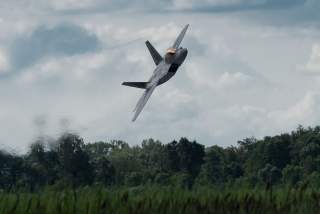The F-22 Will Live and Fight on to 2045 and Beyond
Here's how it will happen.
Key point: The F-22 is an aging aircraft, but a vital one that the Air Force is keen to find ways to keep flying.
The Air Force is rapidly pursuing a new “agile software development” strategy for its F-22 Raptor to quickly equip the stealth fighter with new sensors, improved radar and avionics, faster computer processors and greatly enhanced weapons technology, service officials said.
The acquisition strategy, called Raptor Agile Capability Release (RACR), is led by Air Force Secretary Heather Wilson and is oriented toward implementing new hardware and software upgrades quickly- to keep the F-22 ahead of near-peer fighter aircraft.
The Air Force is now transitioning toward initial production of a new F-22 3.2B software upgrade engineered to enable increase weapons attack technology for the fighter and, as Capt. Emily Grabowski, Air Force spokeswoman, tells Warrior Maven, “enhance the lethality of the F-22 when employing the AIM-120D and AIM-9X.”
The service is now firing off these weapons as part of operational testing of the 3.2B upgrade through formal weapons evaluation process at Eglin, Nellis, Hill, and Tyndall Air Force Base test ranges.
Recommended: 5 Places World War III Could Start in 2018
Recommended: How North Korea Could Start a War
Recommended: This Is What Happens if America Nuked North Korea
While Air Force developers are not quick to pinpoint particular threats or adversaries, many have of course taken note of rapidly advancing Russian air defenses and both Russian and Chinese 5th-Gen stealth aircraft development.
“We need the program to go fast enough to meet the threats the Raptor will face in the future. We are changing our contract structure and taking some risk so that the Air Force can prioritize the things they want on the jet. We want to add capabilities incrementally to the jet,” Ken Merchant, Vice President, F-22, Lockheed, told Warrior Maven in an interview.
Grabowski added that the operational testing and evaluation phase is slated to finish up this coming summer.
“Integrating new software and hardware into weapon systems is a challenge that requires extensive testing. More than 500,000 lines of code have either been modified or added in support of the hardware modifications made to the aircraft,” Grabowski said.
The 3.2B will upgrade F-22 functionality for the AIM-120D and AIM-9X Air-to-Air missiles and enhance Air-to-Surface target location technology. The F-22 currently carries the AIM-9X Block 1 -the current upgrade will enable carriage of AIM-9X Block 2.
Raytheon AIM-9X weapons developers explain that the Block 2 variant adds a redesigned fuze and a digital ignition safety device that enhances ground handling and in-flight safety. Block II also features updated electronics that enable significant enhancements, including lock-on-after-launch capability using a new weapon datalink to support beyond visual range engagements, a Raytheon statement said.
Another part of the weapons upgrade includes engineering the F-22 to fire the AIM-120D, a beyond visual range Advanced Medium-Range Air-to-Air Missile (AMRAAM), designed for all weather day-and-night attacks; it is a "fire and forget" missile with active transmit radar guidance, Raytheon data states.
The AIM-120D is built with upgrades to previous AMRAAM missiles by increasing attack range, GPS navigation, inertial measurement units and a two-way data link, Raytheon statements explain.
As per the ongoing operational testing, Merchant did not elaborate much but did say the weapons systems were “performing as planned.”
Merchant said the agile software approach was, among other things, aimed at helping the F-22 sustain its “first look, first shot, first kill” technology.
Adding new systems and technologies as they become available, instead of launching multi-year developmental programs, is at the core of the “open architecture” strategy, Air Force and Lockheed developers tell Warrior.
The fast-evolving acquisition strategy enables developers to add new computer code at a much faster rate, Merchant said.
“New software will immediately flow into the airplane as we move toward an end state in a more commercially agile software environment,” Merchant said
The accelerated path forward is also intended to pave the way toward and F-22 mid-life update planned for 2024; the idea is to ensure the 80s and 90s-era pumps, values and airframes are sufficiently modernized and kept at an optimal functioning level.
All of this is geared toward the goal of ensuring that the F-22 remains dominant out to 2045 and beyond.
Enabling greater interoperability between the F-22 and other platforms such as the F-35 or 4th-Gen fighters like the F-16 are a crucial part of the agile software modernization process. This includes more complete integration of the LINK 16 data link to enable the F-22 to transmit targeting data without needing a radio, Merchant and Grabowski explained.
“If somebody broke our encryption they could listen to our conversation. LINK 16 transit allows us to share our screen without having any voice pass,” Merchant added.
Once fielded, the F-22 TACLink 16 will enable the F-22 to receive and transmit with other platforms, such as the F-35, F-16, F-15 and others, Grabowski said.
Additional F-35-F-22 LINK 16 tests are planned for 2019 and 2020.
“We won’t generally send in a group of 4th Generation fighters without a Raptor which can see ground targets at a greater range,” Merch said.
First operational in 2005, the F-22 is a multi-role fighter designed with stealth technology to evade enemy radar detection and speeds able to reach Mach 2 with what is called "super-cruise" capability. Supercruise is the ability to cruise at supersonic airspeeds such as 1.5 Mach without needing afterburner, a capability attributed to the engine thrust and aerodynamic configuration of the F-22.
The F-22 is built with two Pratt & Whitney F119-PW-100 turbofan engines with afterburners, Air Force statements said.
The aircraft has a 44-foot wingspan and a maximum take-off weight of more than 83,000 pounds.
This first appeared in Warrior Maven here.
Image: DVIDShub.

